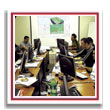|
 When European settlers began to arrive on North American
soil, they brought with them the beliefs and systems of their
cultures. Unfortunately, they also attempted to force these
beliefs and systems on the Aboriginal Peoples that had lived on
the land for hundreds of generations. Education was just one
area in which the assimilation of Aboriginal Peoples was
attempted. The importance of the rich traditional education
imparted to Aboriginal children by their parents and community
Elders was not recognized. For many years, traditional
Aboriginal culture was threatened as children were placed into
residential schools and taught to forget their traditional
educations. When European settlers began to arrive on North American
soil, they brought with them the beliefs and systems of their
cultures. Unfortunately, they also attempted to force these
beliefs and systems on the Aboriginal Peoples that had lived on
the land for hundreds of generations. Education was just one
area in which the assimilation of Aboriginal Peoples was
attempted. The importance of the rich traditional education
imparted to Aboriginal children by their parents and community
Elders was not recognized. For many years, traditional
Aboriginal culture was threatened as children were placed into
residential schools and taught to forget their traditional
educations.
In the 1970s, the destruction of Aboriginal culture reached a
peak and Aboriginal peoples began to turn to themselves and to
their own communities for support. In 1973, the National Indian
Brotherhood issued a paper stating that Aboriginal communities
and bands wished to assume full responsibility for the
educations of their children.1 Until that time, Aboriginal
children attended government-operated schools. Though most of
the residential schools had closed by the 1980s, school
curriculums continued to place little focus on Aboriginal
heritage and offered little chance for children, Aboriginal and
non-Aboriginal alike, to embrace Aboriginal culture in a school
setting.
Traditionally, the education of Aboriginal Peoples was based
on a rich and intimate knowledge of the land and consisted of
mastering the skill necessary for survival in an often-harsh
environment. There were no official schools – the land
functioned as the ‘school’ in which Aboriginal children mastered
their abilities, and community Elders were the ‘teachers’.
While this traditional type of education might be less vital
to the physical survival of Aboriginal Peoples today than it was
in the past, it continues to be integral to the spiritual
survival of many. The significance of preserving and maintaining
traditional Aboriginal education cannot be disregarded. The
government is recognizing the importance of providing Aboriginal
children and youth with an education that meets their unique
needs, and incorporating special programs to suit these needs in
schools and institutions both on and off reserves. At the same
time, school curriculums are being redesigned to increase and
strengthen Aboriginal content.
In Alberta, more attention is being paid to preserving and
showcasing Aboriginal perspectives in school books. Treaty
rights, governance, geography, culture and language are being
explored by students province-wide. This long-overdue approach
is helping Aboriginal children to embrace and preserve their
unique cultures while teaching non-Aboriginal children to value
some of the country’s oldest traditions. In many schools,
increased parental involvement is encouraged. Elders are sharing
their wisdom with students, often by bringing traditional
rituals such as the Sweetgrass Ceremony into the classroom.
Schools which boast a large Aboriginal student population,
usually on reserves, might offer traditional education in
addition to a school-based education. This includes instruction
in traditional teaching, ceremonial dance and song,
spirituality, traditional arts and crafts, recreation, or
languages such as Cree.
Advancements at the post-secondary level have also made it
possible for college and university students to further their
educations while keeping in touch with their culture and
community. Locally-operated colleges and universities fit the
unique needs of Aboriginal students, and in urban areas, many
larger post-secondary institutions have expanded their programs
to offer degrees in Native Studies and Native Education. A large
network of support services functions province-wide to fit the
unique needs of a unique people. All of these programs aim to
increase the representation of Aboriginal Peoples in Canada’s
professional ranks, while bringing Aboriginal perspectives and
interests into a variety of fields."2 The input of Elders is
present in this new blend of traditional and school-based
education, continuing the beautiful traditions of the past in
the ever-changing environment of the present.
Sources:
Berry, Susan, and Jack Brink. Aboriginal Cultures in
Alberta: Five Hundred Generations. Edmonton: Provincial
Museum of Alberta, 2004.
http://www.ainc-inac.gc.ca
http://www.ecsd.net/district_structure/aboriginal_learning.html
ttp://edu.lrrcn.ab.ca/centers/jbs.html
|
 Heritage Community Foundation Presents
Heritage Community Foundation Presents




















